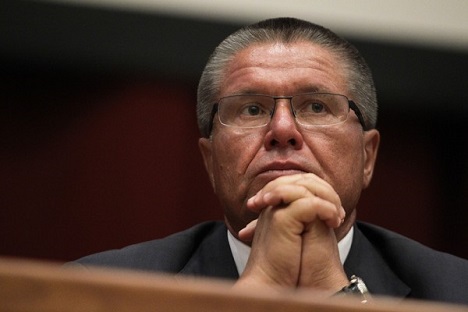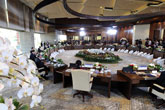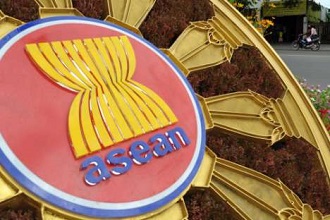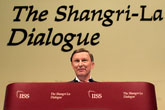Russia should be able to gain foothold in Asia-Pacific markets – Ulyukayev

Alexei Ulyukayev: "ASEAN member states and other countries on both sides of the Pacific are important partners for Russia". Source: Olesya Kurlyaeva/RG
President Vladimir Putin is on an official visit to Vietnam today will then visit the Republic of Korea. What economic goals does Russia have in its cooperation with the Asia-Pacific region and, in particular, with the countries of Southeast Asia?
ASEAN member states and other countries on both sides of the Pacific are important partners for us, and we see that the focus of world politics and economy is shifting to the Asia-Pacific region. In purely economic terms, the rate of growth in this region is responsible for the bulk of the increase in world trade and gross domestic product. That is why establishing close ties with the countries in this region can remove external constraints, allowing Russia to continue to grow.
It is clear that in the current environment, we need to take measures to influence the current economic situation like, for example, attracting large-scale investments from geographically close partners to develop the rich natural resources of Siberia and the Far East. In addition, it would be beneficial to set up joint ventures with companies from the leading countries in the region that would process our energy resources such as oil refineries, liquid natural gas plants, petrochemical and chemical production facilities, and plants for other raw materials.
Another way to revive the economy would be to modernize existing facilities, develop Russian high-tech industries -- aerospace, aviation, and ship building -- and promote innovative projects in the energy sector.
Problems with our transportation infrastructure can be addressed by jointly developing and improving the Euro-Asian transport corridors - the Transiberian line and the Baikal-Amur Mainline - and by modernizing and constructing energy and transport infrastructure in the Far East.
Considering the demand from countries such as China, Vietnam, and Indonesia, Russian companies can confidently increase investments in exploration and development of natural resources; construction of the necessary infrastructure for transport, storage, and processing of raw materials; and construction of new energy infrastructure.
My colleagues and I from the other ASEAN economic ministries have drawn up a road map for trade and investment cooperation between Russia and the ASEAN. At the latest meetings in Brunei we agreed on a work program to implement it, and now are working step by step with the departments and companies on it.
We are also working on establishing a fund to support Russia-ASEAN investment together with the Russian Direct Investment Fund. In general, businesses have many reasons to be more active in the region.
Is it wise for Russia to follow this course, which can be summed up as "Turning Towards the East"? What has been done from an economic point of view that would indicate any growth in trade between Russia and Asia?
Related:

Southeast Asia in global spotlight with APEC, ASEAN & East Asia summits
Russia interested in Trans ASEAN Gas Pipeline project - Lavrov
Russia hopes ASEAN increases investments in different economic sectors
Indeed, the countries of the EU are currently Russia's main trading partner, and account for about half of our foreign trade. Nevertheless, the Asia-Pacific countries are the most promising region for increasing our exports, including those in the hydrocarbon and energy sectors.
Today, our strategic benchmark is for 50 percent of Russia's trade to be with the Asia-Pacific region. Presently, our trade with the Asia-Pacific region is growing at about 1-1.5 percent per year. In 2012, Russia reached record trade volumes with many trading partners in the region: $87.5 billion with China, $31 billion with Japan, and $25 billion with the Republic of Korea.
We have economic cooperation programs with the Republic of Korea, Vietnam, and the ASEAN countries, and will soon have with China, Japan, and Singapore. Cooperation with these countries more often than not means large-scale investment projects, estimated to be worth billions of dollars. Among them are the Russian-Chinese project to build an aluminum plant in Siberia, projects with Japanese companies to build the Vladivostok LNG plant for liquefied natural gas in Vladivostok, a wood-chemical facility in the Yenisei region of Krasnoyarsky Krai, an agro-industrial cluster in Amur region (Singapore), and a cluster of light industry in Primorsky Krai (Vietnam).
Oil, oil products, natural gas, coal, and iron ore make up 65 percent of our exports to Asian countries. The exports of high-tech products last year fell to 2.4 percent, and innovative exports fell to 5.6 percent.
Currently a significant part of our exports to China, South Korea, and Japan are in the energy sector. Frankly, we intend to keep increasing these exports, but we also plan to find partner countries that will invest in processing raw materials on Russian territory, which will allow us to export products with high added value.
Our country can also supply some ferrous metals, basic chemicals, engineering products, and above all, equipment for the energy industry, and military and dual-purpose products. In the long term, Russia should be able to gain a foothold in the Asia-Pacific markets for medium-range aircraft. In the medium term this will be the Superjet, and in the longer term, the MS-21. It is estimated that Asia-Pacific countries will drive up the demand in the future for these products because of the rapid growth in passenger traffic.
Will any major contracts be signed during President Putin's visit to Vietnam?
During Vladimir Putin's visit to Vietnam a number of corporation-level documents will be signed related to extracting and processing hydrocarbons, as well as industrial production and technology transfer.
At signing, the contracts are worth $10-15 billion. Among these projects was a contract for transferring technology for producing rubberized fabric for more than 200 million Euros, the Verkhnaya Salda Metal Producing Company (VSMPO) AVISMA project to build a titanium sponge plant in Vietnam (estimated at $400 million), the Inter RAO UES project for constructing the Quang Chat-2 power plant with BOT conditions (build/operate/transfer) ($2 billion), supplying equipment and services for the planned construction of the Long Fu-1 thermal electric station ($400 million), and OAO Gazprom's participation in the operation and modernization of the Dung Quat refineries (about $3 billion).
In order to ensure reliable delivery, we have selected and approved 12 Vietnam-Russia priority projects that are worth an estimated $10-12 billion. As a result, over the next two or three years we will be able to increase the volume of Russian exports of finished products by $500-700 million!
In addition, Russia's largest oil and gas companies are now laying the groundwork for becoming a regular supplier of hydrocarbons to Vietnam, which also will increase the total volume of trade.
Another promising area for cooperation is in developing free trade zones. Vietnam is currently working on establishing a free trade area with the Customs Union of Russia, Belarus and Kazakhstan. The next round of talks is scheduled for December of this year. We are hoping to conclude this long and complex project very soon.
All rights reserved by Rossiyskaya Gazeta.
Subscribe
to our newsletter!
Get the week's best stories straight to your inbox

